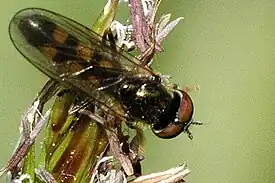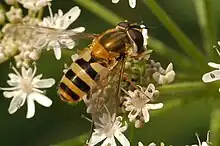Syrphidae of New York State
Total of 245 species either found or highly expected to be found in New York.
Subfamily ERISTALINAE
Tribe Brachyopini
- This tribe contains 8 genera and 31 or likely more species found in New York State
| Genus | authority | common name | # in N.Y. | Defining characteristics |
|---|---|---|---|---|
| Brachyopa | Meigen, 1822 | Sapeater Fly | 8 | Face and scutellum tan to orange or yellow. Last section
of R4+5 vein shorter than crossvein h. |
| Chrysogaster | Meigen, 1803 | Wrinkleheaded Fly | 1 | Last section of R4+5 longer than crossvein r-m. Face entirely black. Antennae on lower part of head. |
| Chrysosyrphus | Sedman, 1965 | Wrinkleheaded Fly | 1 | like Chrysogaster but antennae on upper part of head. |
| Hammerschmidtia | Schummel, 1834 | Logsitter Fly | 2 | postalar callus, and scutellum with strong bristles. Hind tibia with short strong black spines. |
| Myolepta | Newman, 1838 | Pegleg Fly | 3 | Front and middle femora with short strong spines near the apex. |
| Neoascia | Williston, 1886 | Fen Fly | 3 | Small flies with petiolate abdomen, M1 forming a right angle with R4+5. |
| Orthonevra | Macquart, 1829 | Mucksucker Fly | 4 | flagellum at least twice as long as wide. Eyes with horizontal or meandering lines. |
| Sphegina | Meigen, 1822 | Pufftail Fly | 9 | Abdomen petiolate. Swollen hind femur with ventral spines. |
Genus Brachyopa
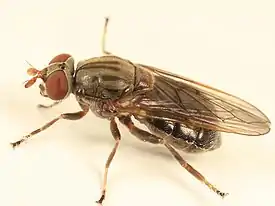
Genus Chrysogaster
- Chrysogaster antitheus (Walker, 1849) [1] The Short-haired Wrinklehead is a fairly common species.
Genus Chrysosyrphus
- Chrysosyrphus latus ( (Loew, 1863) The Variable Wrinklehead is a rare species
Genus Hammerschmidtia
Hammerschmidtia is a Holarctic Genus of hoverflies. The larvae are found in sap under the bark of downed trees.[2] They appear quite unlike other syrphids, having drab colors and numerous bristles but on closer inspection they do have the general indicators of syrphids in a spurious vein.[3]
- Hammerschmidtia rufa, The Black-bristled Logsitter is an uncommon species.
- Hammerschmidtia sedmani Pale-bristled Logsitter is a rare species in N.Y.
Genus Myolepta
Three species of Myolepta occur in New York.[3] Keys and descriptions of this species was made by Fluke and Weems in 1956.[4] Larvae are described by Rotheray [5]
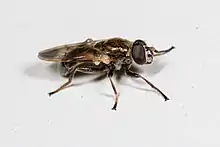
Genus Neoascia
Neoascia (Williston, 1886)[6] Fen Flies These are very small (3.5–5 mm) black and yellow or metallic green flies with a narrow abdomen near the thorax. They occur mainly in damp places around plants. . Neoascia larvae have been recovered from wet manure in farmyards, and decaying vegetation at the edges of ponds.[7] In 1925 Curran reviewed the Genus Neoascia [8]
- Neoascia metallica (Williston, 1882 )[9] The Double-banded Fen Fly, is a common species.
- Neoascia tenur (Harris, 1780) [10] The Black-kneed Fen Fly is a common species that was formerly considered to be only European now considered to be throughout North America and Canada.[11]
- Neoascia globosa (Walker, 1849)[1] The Black-margined Fen Fly is a fairly common species.
Genus Orthonevra
Four species Orthonevra (Macquart, 1829) of these small dark metallic flies are found in New York. Sedman divided this genus into two groups, the pictipennis group [12] of which N.Y. has O. pictipennis, O. Weemsi and O. pulchella and the Bellula group [13] with O. nitida being found in N.Y. This genus is one of the few where the eyes are ornamented with either horizontal medial lines or meandering lines across the eye. Keys and descriptions have been provided by Sedman.[12][13]
- Orthonevra nitida (Wiedemann, 1830)[14] The Wavy mucksucker is a fairly common species.
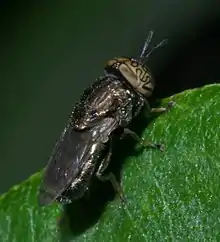
- Orthonevra pictipennis (Loew, 1863) [15] Dusky-veined Mucksucker is an uncommon species.
- Orthonevra pulchella (Williston, 1887) [6] The Dusky Mucksucker is a fairly common species.
- Orthonevra weemsi (Sedman, 1966) [12] Weems' Mucksucker is a rare species.
Genus Sphegina
.jpg.webp)
These are distinctive small flies with a thin elongate abdomen and enlarged hind femur often with spines and or teeth. The larvae are found under bark in water soaked areas. Rotheray[7] has described European species and habitats as well as a key to larvae including sphegina and other syrphid genera. Keys to adult American species was provided by Coovert.[16] New York species can also be found southward especially in the Appalachian Mountains and also north to the New England States.
There are various keys online, Covert 1977[16] Hull, 1935 [17] and Malloch, 1922 [18]
:{|class="wikitable"
|-! name !! authority !! common name!!prevalence |+ Sphegina (Meigen, 1822) |- |Sphegina brachygaster || Hull, 1935[17] || Thick-waisted Pufftail || fairly common |- | Sphegina campanulata || Robertson, 1901[19] ||Orange-horned Pufftail || fairly common |- |Sphegina flavimana || John Russell Malloch,1922 [18] || Tuberculate Pufftail || fairly common |- |Sphegina flavomaculata|| John Russell Malloch,1922 [18] || Tooth-legged Pufftail|| uncommon |- |Sphegina keeniana|| Williston,1887 [6] || Peg-legged pufftail || fairly common |- |Sphegina lobata || Loew, 1863 [15] ||Yellow-lobed Pufftail || uncommon |- |Sphegina lobulifera || John Russell Malloch,1922 [18] || Black-lobed Pufftail || uncommon |- |Sphegina petiolata|| Coquillett, 1910[20] || Long-spined Pufftail || uncommon |- |Sphegina rufiventris|| Loew, 1910 [15] || Black-horned pufftail || common |- |}
Genus Callicera
Only one species of this tribe is found in New york in the genus Callicera (Panzer, 1809).
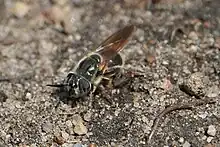
- Callicera erratica (Walker, 1849) [1] The Golden Pine Fly is a rare species.
Genus Ceriana
Ceriana(Rafinesque, 1815) has but one species in New York.
- Ceriana abbreviata (Loew, 1864) [21] The Northern Wasp Fly
Genus Sphiximorpha
Sphiximorpha (Rondani, 1850) is represented by a single rare species in New York.
- Sphiximorpha willistoni (Kahl, 1897) [22] Williston's Wasp Fly is a rare species.
Genus Eristalinus
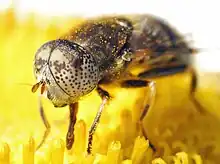
- Eristalinus aeneus (Scopoli, 1763) The Common Lagoon Fly is fairly common.
Genus Eristalis
New York has an prevalence of Eristalids many of which are striking in color and exhibit mimicry to the bees. The larvae are of the rat-tailed type. Eristalis along with many sister species has the r4+5 vein making a distinct loop towards the rear of the wing.[11]

- Species list
Genus Palpada
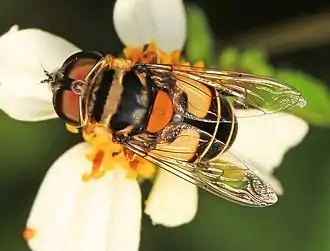
- Palpada albifrons (Weidemann 1830) [14] The White-faced Plushback is a rare vagrant
- Palpada vinetorum (Fabricius 1799) The Northern Plushback is a fairly common species
Subtribe Helophilina
| Genus | Thorax | Abdomen | Hind tibia | Other |
|---|---|---|---|---|
| Notes | This table is confined to New York species. | |||
| Helophilus, key [23] | Longitudinal stripes | Abdomen oval, with large orange markings | variable | Stigma long |
| Anasimia, key ( as Lejops) [23] | Longitudinal stripes | narrow | variable | |
| Polydontomyia, single species | not striped | slightly narrowed, black with solid yellow-orange behind, all brownish gray in female | arcuate and produced into a long apical spur | |
| Mallota, key [24] | not striped, Thick pile | compact and thick pile | without long apical spur | bumblebee mimic |
| Parhelophilus, Key [25] | longitudinal stripes | compact | truncate at apex. | stigma short |
| Eurimyia, single species | longitudinal stripes | sawtooth yellow spots | without long apical spur, two black rings | face produced into an elongate cone |
Genus Eurimyia
- Eurimyia stipata the Long-nosed Swamp Fly.[23]
Genus Anasimyia
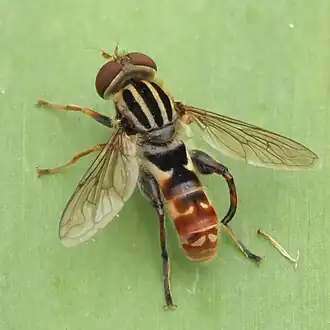
Genus Polydontomyia
- Polydontomyia curvipes (Weidemann,1830) [14] The Dimorphic Sickleleg is locally common along salt marshes.
Genus Mallota
Large flies that strongly resemble bumblebees. The larvae of, M. cimhiciformis (Fallen) and M. posticata (Fabricius) develop in detritus-containing rot pockets, usually wet tree holes in upright deciduous trees. [26]
- Mallota cimbiciformis, (Fallén, 1816) [27]
- Mallota bautias Walker 1849 [1] The Bare-eyed Mimic is a common species
- Mallota posticata,Fabricius 1805,[28] The Hairy-eyed Mimic is a common species.
Genus Parhelophilus
Tribe Sericomyiini
This tribe has only one genus
Genus Sericomyia
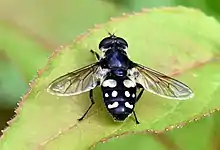
- Sericomyia chrysotoxoides (Macquart 1842) [29] The Oblique-banded Pond Fly is a common species.
- Sericomyia lata (Coquillett 1907) [30] The White-spotted Pond Fly is a common species.
- Sericomyia militaria (Walker, 1849) [1] The Narrow-banded Pond Fly is a common species.
- Sericomyia transversa (Osburn, 1926)[31] The Yellow-spotted Pond Fly is an uncommon species.
Tribe Eumerini
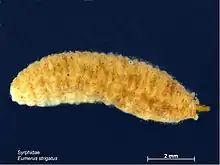
Genus Eumerus
- Eumerus funeralis (Meigen, 1822) [32] Lesser Bulb Fly is a fairly common species.
- Eumerus strigatus (Fallén, 1817) [27] Onion Bulb Fly is a fairly common species.
Genus Merodon
- Merodon equestris (Fabricius, 1794)[33] The Narcissus Bulb Fly is a fairly common species.
Tribe Milesiini
This tribe contains 17 genera with 56 species found in New York
| name | authority | common name | # in N.Y. | Defining characteristics |
|---|---|---|---|---|
| Blera | Billberg, 1820 | Wood Fly | 7 | distinct frontal prominence, face downward and forward |
| Brachypalpus | Macquart, 1834 | Catkin Fly | 1 | triangular face, thorax with thick yellow pile |
| Chalcosyrphus | Curran, 1925 | Leafwalker | 10 | slender abdomen, enlarged hind femur, often orange legs. |
| Criorhina | Meigen, 1822 | Bumblefly | 2 | large bumblebee mimics. |
| Cynorhinella | Curran, 1922 | Longnose Fly | 1 | small thin black fly with large conical face. |
| Hadromyia | Williston, 1882 | Quicksilver Fly | 1 | black fly metallic patches on abdomen |
| Lejota | Wahlberg, 1843 | Trunksitter Fly | 2 | all black fly with distinct frontal prominence and straight face. |
| Milesia | Latreille, 1804 | Giant Flower Flies | 1 | large yellow and black yellowjacket mimic |
| Pterallastes | Loew, 1863 | Goldenback Fly | 1 | large fly with bright golden thorax. . |
| Somula | Macquart, 1847 | Wood Fly | 1 | large fly with distinct antennifer and bright yellow abdominal spots. |
| Sphecomyia | Latreille, 1829 | Yellowjacket Fly | 1 | long antennae black and yellow striped abdomen. |
| Spilomyia | Meigen, 1803 | Hornet Fly | 4 | vertical eye stripe, yellow and black thorax and abdomen. |
| Syritta | Linnaeus, 1758 | Compost Fly | 1 | inflated hind femur with orange spots, abdomen with rounded spots |
| Temnostoma | Le Peletier & Serville | Falsehorn Fly | 7 | yellow stripe along transverse suture, abdomen with one or two stripes on each segment. |
| Teuchocnemis | Osten Sacken, 1876 | Spur Fly | 2 | males with large spur on hind tibia |
| Tropidia | Meigen, 1822 | Thickleg Fly | 3 | hind femur enlarged with triangular shaped process ventrally |
| Xylota | Meigen, 1822 | Leafwalker | 11 | slender abdomen, enlarged hind femur, abdomen black or with yellow spots. |
Genus Blera
.jpg.webp)
Genus Brachypalpus
- Brachypalpus oarus (Walker, 1849) [1] The Eastern Catkin Fly is a fairly common species.

Genus Chalcosyrphus
- C. anthreas (Walker, 1849)
- C. chalybeus (Wiedemann, 1830)
- C. curvaria (Curran, 1941)
- C. inarmatus (Hunter, 1897)
- C. libo (Walker, 1849)
- C. metallifer (Bigot, 1884)
- C. nemorum (Fabricius, 1805)
- C. piger (Fabricius, 1794)
- C. plesia (Curran, 1925)
- C. vecors (Osten Sacken 1875)
Genus Criorhina
- Criorhina verbosa (Walker, 1849) [1] The Hairy-cheeked Bumble Fly is an uncommon species.
- Criorhina nigriventris (Walton, 1911) [34] The Bare-cheeked Bumble Fly is an uncommon species.
Genus Cynorhinella
Cynorhinella (Curran, 1922) is a rare genus in New York with a single species.
- Cynorhinella longinasus (Shannon, 1924) [35] The Eastern Longnose Fly is a rare species.
Genus Hadromyia
Hadromyia (Williston, 1882) a single species in New York
- Hadromyia aepalius (Walker, 1849) [1] Sterling Quicksilver Fly is a rare species.
Genus Lejota
Lejota (Róndani, 1857) has two uncommon species in New York.
- Lejota aerea (Loew 1872) [36] The Golden Trunksitter is an uncommon species
- Lejota cyanea (Smith 1912) [37] The Cobalt Trunksitter is an uncommon species.
.jpg.webp)
Genus Milesia
Milesia (Latreille, 1804) represented by a single, vivid species.
- Milesia virginiensis (Drury, 1773) The Virginia Giant is an uncommon species.
Genus Pterallastes
Pterallastes (Loew, 1863)
- Pterallastes thoracicus (Loew 1863) [15] The Goldenback Fly is an uncommon species.

Genus Somula
Somula (Macquart, 1847) has only two species worldwide, with one in New York.
- Somula decora (Macquart, 1847)[38] The Spotted Wood Fly is an uncommon species.
Genus Sphecomyia
Sphecomyia Latreille, 1829 is a genus of wasp mimics with one species found in New York.
- Sphecomyia vittata (Wiedemann, 1830) [14] The Long-horned Yellowjacket is an uncommon species.
Genus Spilomyia
Many species in Spilomyia are wasp mimics with black and yellow patterns and using the black front legs to imitate the wasp antennae. [39] The eyes on Spilomyia species are a distinctive characteristic which usually display vertical, and irregular stripes or blotches.[40]
- Spilomyia alcimus (Walker 1849) [1] Broad-banded Hornet Fly is an uncommon species.
- Spilomyia fusca (Loew 1864) [21] Bald-faced Hornet Fly is a fairly common species.
- Spilomyia longicornis (Loew 1872) [36] Eastern Hornet Fly is an uncommon species
- Spilomyia sayi (Goot, 1964) Four-lined Hornet Fly is a fairly common species.
.jpg.webp)
Genus Syritta
.jpg.webp)
- Syritta pipiens (Linnaeus, 1758 ) The Common Compost Fly is a very common species.
Genus Temnostoma
- Temnostoma alternans Loew, 1864
- Temnostoma balyras (Walker, 1849)
- Temnostoma barberi Curran, 1939
- Temnostoma daochus (Walker, 1849)
- Temnostoma excentricum Harris, 1841
- Temnostoma trifasciatum Robertson, 1901
- Temnostoma venustum Williston, 1887
Genus Teuchocnemis
Teuchocnemis (Osten-Sacken, 1876) species are more commonly found south of New York.
- Teuchocnemis bacuntius (Walker, 1849) [1] The Orange Spur Fly is a rare species.
- Teuchocnemis lituratus (Loew, 1863) [15] The Black Spur Fly is an uncommon species.
Genus Tropidia
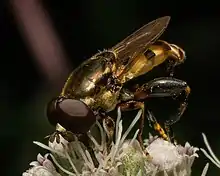
- Tropidia albistylum (Macquart, 1847) [38] The Yellow-thighed Thickleg Fly is a rare species
- Tropidia calcarata (Williston, 1887) [6] The Lily-loving Thickleg Fly is a rare species.
- Tropidia quadrata (Say, 1824) [41]The Common Thickleg Fly is a common species.
Genus Xylota
- Xylota angustiventris Loew, 1866
- Xylota annulifera Bigot, 1884
- Xylota bicolor Loew, 1864
- Xylota confusa Shannon, 1926
- Xylota ejuncida Say, 1824
- Xylota flavifrons Walker, 1849
- Xylota hinei (Curran, 1941)
- Xylota naknek Shannon, 1926
- Xylota quadrimaculata Loew, 1866
- Xylota segnis (Linnaeus, 1758)
- Xylota subfasciata Loew, 1866
Tribe Rhingiini
This tribe contains 5 genera and 8 species found in New York State
| Genus | authority | common name | # in N.Y. | Defining characteristics |
|---|---|---|---|---|
| Cheilosia | Meigen, 1822[ | blacklet | 4 * | Small black flies with grooves along margin of face below the antennae. The face is distinctly tuberculate with a notched oral cavity. |
| Ferdinandea | (Loew, 1863 | Copperback | 1 | striped scutum, bristles on scutum and scutellum |
| Hiatomyia | Shannon, 1922 | Deltawing | 1 | small black flies with bare eyes and plumose arista |
| Pelecocera | (Meigen, 1822 | Bighorn Fly | 1 | Small flies with an elongate abdomen, flagellum terminal style with an enlarged base |
| Rhingia | Scopoli, 1763 | Snout Fly | 1 | very long, forward directed snout and a black with large yellow spotted abdomen. |
| * additional species of cheilosia are likely to be found in New York. | ||||
Genus Cheilosia
This is a very large genus of little black flies with larvae feeding on plants or fungi.
- Species observed in New York
- Species observed next to New York
Genus Ferdinandea
Ferdinandea (Róndani, 1844) has a single species in New York with a second species, Ferdinandea croesus, reported but the identity is not confirmed.[11]
- Ferdinandea buccata (Loew, 1863) [15] The Common Copperback a fairly common species.
Genus Hiatomyia
- Hiatomyia cyanescens (Hunter, 1896) no page The Azure Deltawing an uncommon species.
Genus Pelecocera
Pelecocera (Meigen, 1822) [32] only reported from Long Island but may be more common as the small size and habit of staying in low lying flowers may make this fly under-reported.
- Pelecocera pergandei.(Williston, 1884) The Eastern Bighorn Fly is a very rare species.
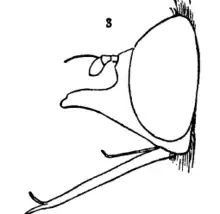
Genus Rhingia
Rhingia(Scopoli, 1763) has only one species in North America.
- Rhingia nasica (Say, 1823) The American Snout Fly is a common species.
Genus Copestylum
Copestylum (Macquart, 1846) due to the larval habit of living in Bromeliads only one species is found in New York.
- Copestylum vittatum Tropical Plushback The Striped Bromeliad Fly is an uncommon species.
Genus Volucella
Volucella (Geoffroy, 1762) has two species that represent some of the best bumblebee mimics in New York. The larvae of most species live in nests of bumblebees and social wasps, where they are detritivores and larval predators.[42]
- Volucella evecta (Walker, 1852) The Eastern Swiftwing is an uncommon species.
- Volucella facialis (Linnaeus, 1758) The Yellow-faced Swiftwing is a fairly common species.
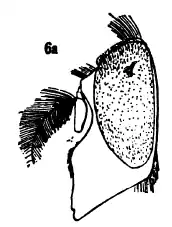
Subfamily PIPIZINAE
This is the newest subfamily and the smallest in New York. The adult fly looks very much like the flies in Eristalinae while the larvae are predators much like the subfamily Syrphinae.[43] The DNA evidence has been evaluated and concluded that Pipizinae are a sister subfamily to these subfamilies.[44]
Genus Heringia
- Heringia calcarata (Loew, 1866) [45] Opaque Spikeleg Fly
- Heringia canadensis, Curran, 1921, The Canadian Smoothleg Fly is a fairly common species
- Heringia salax, Loew, 1866 [45] The Eastern Smoothleg Fly is a fairly common species
- Heringia coxalis (Curran, 1921) White-faced Spikeleg Fly
- Heringia elongata (Curran, 1921) Elongate Spikeleg Fly
- Heringia rita (Curran, 1921) Black-faced Spikeleg Fly
Genus Pipiza
Pipiza (Fallén, 1810) is a genus of small nearly all black flies sometimes with yellow abdominal spots. The larvae, when known, feed upon gall making or leaf rolling aphids. Pipizini. The larvae of Pipiza species (fig. 257) seem to prefer aphids which secrete a waxy flocculence, e.g. woolly aphid (Eriosoma). Pipizella larvae confine their attention to subterranean aphids feeding on the roots of plants.
- Pipiza femoralis (Loew, 1866)[45] The White-haired Pithead Fly
- Pipiza macrofemoralis (Curran, 1921) The Large-legged Pithead Fly is an uncommon species in New York
- Pipiza nigripilosa (Williston, 1887) The Pale-haired Pithead Fly is a common species.
- Pipiza puella (Williston, 1887) The Sumac Gall Pithead Fly is a common species.
- Pipiza quadrimaculata (Panzer, 1804) The Four-spotted Pithead Fly is a fairly common species.
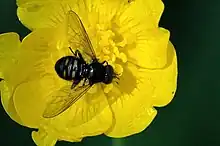
Genus Trichopsomyia
Trichopsomyia (Williston, 1888) is another genus of small black flies that may easily be overlooked. Pipizella larvae confine their attention to subterranean aphids feeding on the roots of plants.
- Trichopsomyia apisaon (Walker, 1849) [1] The Black-haired Psyllid-killer
- Trichopsomyia recedens (Walker, 1852) The Shadowy Psyllid-killer
Subfamily MICRODONTINAE
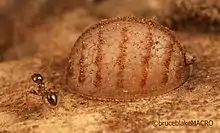
Genus Microdon
The nine New York species is a fraction of the 126 worldwide species. The Microdon larvae live in the nests of ants as scavengers or predators and unlike other syrphid larvae, have no apparent body segmentation.
- Microdon abstrusus,Thompson, 1981 Hidden Ant Fly [46]
- Microdon abditus Thompson, 1981 Broad-footed Ant Fly
- Microdon cothurnatus Bigot, 1884 [47] Orange-legged Ant Fly
- Microdon globosus Fabricius, 1805 [28] Globular Ant Fly
- Microdon manitobensis Curran, 1924 Greater Ant Fly [48]
- Microdon megalogaster Snow, 1892 Black-bodied Ant Fly
- Microdon ocellaris|| Curran, 1924 .,Hairy-legged Ant Fly .[48]
- Microdon ruficrus Williston, 1887 Spiny-shield Ant Fly
- Microdon tristis Loew, 1864 [21] Long-horned Ant Fly|
Genus Mixogaster
- Mixogaster breviventris (Kahl, 1897) The Slender Ant Fly is a rare species.
Subfamily SYRPHINAE
The larvae of Syrphinae are predators of aphids and other plant feeding insects. The role in controlling populations if these occasionally destructive "plant lice' is of interest to science as a possible bological control agents. The adult flies are small to medium sized, many with black and yellow patterning. Many species have elongate bodies. The four tribes of the Syrphidae are well represented in New York with the Syrphini being the most divers and numerous of the tribes while Toxomerini contains the most numerous and widespread species Toxomerus marginatus found across new york for much of the summer.
Genus Baccha
Baccha (Fabricius, 1805) [28] has only one species in New York that is easily overlooked because of its small size.
- Baccha elongata (Cognata) (Fabricius, 1775) The Common Dainty Fly a common species.
Genus Melanostoma
(Schiner, 1860)
- Melanostoma mellinum (Linnaeus, 1758) The Variable Duskyface is an abundant species.
Genus Platycheirus
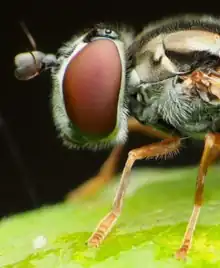
A very large genus, perhaps 220 species worldwide and 23 species possibly in New york. In New York state Platycheirus is divided into seven morphological groups based on the shape and ornamentation of the front tarsi and tibia and other characteristics. press "show" below to see table. Species can be difficult to identify, especially females. A key, description, maps, photographs [49] has been published and contains keys to both male and female of the species where possible,
Platycheirus morphological groups for males only group front leg other Albimanus Expanded probasitarsus, Tibia expanded over entire length Ambiguus Long curled seta at apex of profemur Granditarsus Expanded probasitarsus in P. granditarsus unmodified on P. rosarium Distinctive abdominal markings Maniculatus Expanded probasitarsus, Peltatus Expanded probasitarsus, tibia expanded at apex Pictipes Unmodified proleg Sengus Long posterior black seta on pro- and meso-tibia facial pollinosity arranged in oblique ripples or punctures
- Species:
- Platycheirus angustatus
- P. clypeatus
- P. coerulescens
- P. confusus
- P. discimanus
- P. granditarsus
- P. hyperboreus
- P. immarginatus
- P. inversus
- P. modestus
- P. nearcticus
- P. nodosus
- P. normae
- P. obscurus
- P. pictipes
- P. quadratus
- P. rosarum
- P. scamboides
- P. scambus
- P. scutatus
- P. thompsoni
- P. thylax
- P. varipes
Genus Chrysotoxum
Chrysotoxum (Meigen, 1803)
- Chrysotoxum flavifrons, Macquart, 1842 [29] The Blackshield Meadow Fly
- Chrysotoxum laterale, Loew, 1864 [21]
- Chrysotoxum pubescens, Loew, 1864 [21] The Yellow-throated Meadow Fly
- Chrysotoxum plumeum, Loew 1864,[21] The Broad-banded Meadow Fly
Tribe Paragini
.jpg.webp)
Genus Paragus
- Paragus angustifrons (Loew, 1863) [15] Narrow-faced Grass Skimmer
- Paragus tibialis (Fallén, 1817)[27]
- Paragus haemorrhous (Meigen, 1822) [32] Black-backed Grass Skimmer
- Paragus angustistylus (Vockeroth, 1986) Thin-spined Grass Skimmer
Tribe Syrphini
Syrphini this tribe contains 15 genera and at least 38 species, though more are likely*, found in New York
| Genus | authority | common name | # in N.Y. | Defining characteristics |
|---|---|---|---|---|
| Allograpta | Osten Sacken, 1875 | streaktail | 1 | small flies, thorax sides with yellow stripe, last abdominal segments lateral bands and parallel stripes. |
| Dasysyrphus | Enderlein, 1938 | Conifer Fly | 4 | eyes pilose, abdominal margin grooved, abdomen variable yellow markings. |
| Didea | Macquart, 1834 | Lucent | 1 | sinuous r4+5 vein, distinct yellow spots |
| Doros | Meigen, 1803 | Potterfly | 1 | shiny black and yellow, wasp mimics. |
| Epistrophe | Walker | Smoothtail | 3 | straight R4+5 vein lateral yellow spots on seg. 2, yellow bands on seg. 3&4 |
| Epistrophella | Dušek & Láska, 1967 | Smoothtail | 1 | article needed. |
| Eupeodes | Osten Sacken, 1877 | Aphideater | 5* | R4+5 straight, abdomen marginate |
| Lapposyrphus | Dušek & Láska, 1967 | Aphideater | 1 | vein R 4+5 distinctly dipped, yellow abdminal spots variable |
| Leucozona | Schiner, 1860 | none | 1 | thickly pilose, white anterior abdomen |
| Megasyrphus | Dusek & Láska, 1967 | Gossamer Fly | 1 | vein R4+5 sinuous, distinct abdominal bands |
| Melangyna | Verrall, 1901 | Halfband | 3 | working on it |
| Meligramma | Frey, 1946 | Roundtail | 1 | vein R4+5 straight, slender abdomen with yellow spots along the sides. |
| Meliscaeva | Frey, 1946 | Thintail | 1 | vein R4+5 straight, abdomen thin with broad yellow bands |
| Ocyptamus | Macquart, 1834 | Hover Fly | 1 | very long slender abdomen, brown wing cloud. |
| Parasyrphus | Matsumura, 1917 | Bristleside | 1 * | under review |
| Sphaerophoria | Le Peletier & Serville, 1828 | Globetail | 5 * | straight R4+5 vein, slender abdomen with yellow stripes, scutum with lateral yellow stripes, male genitalia globose. |
| Syrphus | Fabricius, 1775 | Flower Fly | 5 | straight R4+5, yellow face and scutellum, dorsal side of lower calypter pilose. |
| Xanthogramma | Schiner, 1860 | Harlequin Fly | 1 | yellow stripes on scutum black, brown and yellow stripes on abdomen. |
_-_Guelph%252C_Ontario_03.jpg.webp)
Genus Allograpta
Allograpta (Osten Sacken, 1875),[50] once recognized is found to be a common species across the state along with Toxomerus.
- Allograpta obliqua (Say, 1823) Say, T. 1823. Descriptions of dipterous insects of the United States. J. Acad. Nat. Sci. Philad. Oblique Streaktail
Genus Dasysyrphus
Dasysyrphus (Enderlein, 1938) have recently been reviewed.[51]
- Dasysyrphus laticaudus (Curran, 1925) [52]Boreal Conifer Fly
- Dasysyrphus limatus (Hine, 1922) Narrow-banded Conifer
- Dasysyrphus venustus (Meigen), 1822 [32] Transverse Conifer Fly
- Dasysyrphus intrudens (Osten Sacken, 1877) Confusing Conifer Fly
Genus Didea
Didea (Macquart, 1834) has a single species in New York.
- Didea fuscipes (Loew, 1863) [15] Undivided Lucent Fly
Genus Epistrophe
- Epistrophe grossulariae (Meigen, 1822) [32] Black-horned Smoothtail
- Epistrophe nitidicollis (Meigen, 1822) [32] Straight-banded Smoothtail
- Epistrophe xanthostoma (Williston, 1887) Emarginate Smoothtail
Genus Epistrophella
Epistrophella emarginata (Say, 1823) Slender Smoothtail
Genus Eupeodes
- Eupeodes americanus (Wiedemann, 1830) [14] Long-tailed Aphideater
- Eupeodes latifasciatus (Macquart, 1829) Variable Aphideater
- Eupeodes perplexus (Osburn, 1910) Bare-winged Aphideater
- Eupeodes pomus (Curran, 1921) Short-tailed Aphideater
- Eupeodes volucris (Osten Sacken, 1877) bird hoverfly
Genus Lapposyrphus
- Lapposyrphus lapponicus (Zetterstedt, 1838) Common Loopwing Aphideater
Genus Leucozona
Leucozona (Schiner, 1860) with one distinct species in New York. Another species, Leucozona xylotoides, has been observed in states bordering the eastern border of New York.
Leucozona americana (Curran, 1923) American Whitebelt .
Genus Megasyrphus
- Megasyrphus laxus (Osten Sacken, 1875) [50] Black-legged Gossamer
Genus Melangyna
Melangyna (Verrall, 1901)
- Melangyna fisherii(Walton, 1911) [34] Large-spotted Halfband
- Melangyna lasiophthalma (Zetterstedt, 1843) Hair-eyed Halfband
- Melangyna umbellatarum (Fabricius, 1794)[33] Bare-winged Halfband
Genus Meligramma
The Meligramma (Frey, 1946) species in New York is also common in Europe
- Meligramma triangulifera (Zetterstedt, 1843)[53] Variable Roundtail
Genus Meliscaeva
Meliscaeva (Frey, 1946) our one species is also common in Europe.
- Meliscaeva cinctella[53] Common Thintail
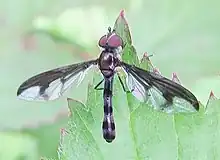
Genus Ocyptamus
- Ocyptamus fuscipennis (Say, 1823) [54] Dusky-winged Hover Fly
Genus Parasyrphus
- Parasyrphus vockerothi Thompson 2012 [55] Vockeroth's Bristleside
Genus Philhelius
- Philhelius flavipes (Loew, 1863) [15] American Harlequin Fly
Genus Sphaerophoria
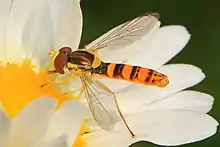
New York species all with bright yellow and black abdominal markings the thorax is dark with yellow scutellum. yellow markings along the sides and hemispherical male terminalia
- Sphaerophoria asymmetrica (Knutson, 1973) [56] Asymmetric Globetail
- Sphaerophoria contigua (Macquart, 1847) [38] Tufted Globetail
- Sphaerophoria novaeangliae (Johnson, 1916) [57] Black-striped Globetail
- Sphaerophoria philanthus (Meigen, 1822) [32] Black-footed Globetail
Genus Syrphus
- Syrphus knabi The Eastern Flower Fly.
- Syrphus rectus The Yellow-legged Flower Fly.
- Syrphus torvus The Hairy-eyed Flower Fly
- Syrphus vitripennis The Black-legged Flower Fly.
Tribe Toxomerini
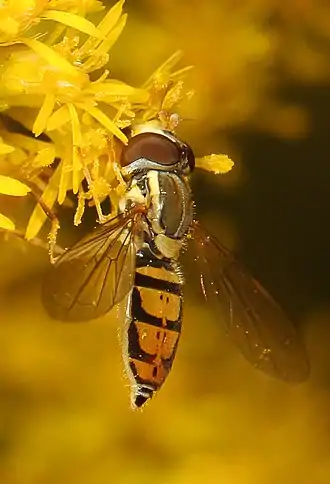
Genus Toxomerus
- Toxomerus marginatus (Say, 1823) Margined Calligrapher, the most common hoverfly in New York
- Toxomerus politus (Say, 1823) Maize Calligrapher
- Toxomerus geminatus (Say, 1823)[6] Eastern Calligrapher
References
- Walker, F. (1849). List of the specimens of dipterous insects in the collection of the British Museum. Part III. London: British Museum (Natural History). pp. 485–687.
- Rotheray, G.E. (1993). "Colour Guide to Hoverfly Larvae (Diptera, Syrphidae) in Britain and Europe" (PDF). Dipterists Digest. 9: 155.
- Skevington, Jeffrey H (2019). Field Guide to the Flower Flies of Northeastern North America. Princeton University Press. ISBN 9780691189406.
- Fluke, C.L. (1956). "The Myoleppini of the Americas". Am. Mus. Novit. 1758: 1–23. hdl:2246/2452.
- Rotheray, G.E. (1993). "Colour Guide to Hoverfly Larvae (Diptera, Syrphidae) in Britain and Europe" (PDF). Diperists Digest. 9: 155.
- Williston, S. W. (1887). "Synopsis of the North American Syrphidae". Bulletin of the United States National Museum. 31: xxx + 335. Retrieved 1 July 2015.
- Rotheray, G.E. (1993). "Colour Guide to Hoverfly Larvae (Diptera, Syrphidae) in Britain and Europe" (PDF). Diperists Digest. 9: 155.
- Curran, C.H. (1925). "Revision of the Genus Neoascia". Proc. Ent. Soc. Wash. 27: 51–62.
- Williston, Samuel Wendell (1882). "Contribution to a monograph of the North American Syrphidae". Proc. Amer. Philos. Soc. 20 (112): 299–332. Retrieved 23 July 2021.
- Harris, M. (1780). An exposition of English insects. Vol. Decads III, IV. London: Robson Co. pp. 73–99, 100–138, pls. 21–30, 31–40. Retrieved 16 July 2021.
- Skevington, J.H.; Locke, M.M.; Young, A.D.; Moran, K.; Crins, W.J.; Marshall, S.A (2019). Field Guide to the Flower Flies of Northeastern North America. Princeton Field Guides (First ed.). Princeton, New Jersey: Princeton University Press. p. 512. ISBN 9780691189406.
- Sedman, Y. S. (1966). "The Chrysogaster (Orthonevra) pictipennis group in North America". Proceedings of the Entomological Society of Washington. 68: 185–194.
- Sedman, Yale S (1964). "The Chrysogaster (Orthonevra) Bellula Group In North America". Proceedings of the Entomological Society of Washington. 66: 169–201.
- Wiedemann, Christian.R.W. (1830). Aussereuropäische Zweiflügelige Insekten Hamm, in der Schulzischen Buchhandlung (PDF). Zweiter Theil. Schulz, Hamm. p. 684.
- Loew, H. (1863). "Diptera Americae septentrionalis indigena". Berliner entomologische Zeitschrift. 7: 275–326.
- Coovert, G. A (1977). "The Sphegina species of eastern North America". Proc. Biol. Soc. Wash. 90: 536–552.
- Hull, Frank (1935). "Descriptions of new species of the Genus Sphegina with a key to those known from North America". Transactions of the American Entomological Society. 61: 373–38.
- > Malloch, John Russell (1922). "Seven new species of the syrphid Genus Sphegina Meigen". Proceedings of the Biological Society of Washington. Biological Society of Washington. 35: 141–144.
- Robertson, Charles (1901). "Some New Diptera". The Canadian Entomologist. 33 (10): 285–286. doi:10.4039/Ent33284-10. S2CID 86059410.
- Coquillett, D.W. (1910). "New genera and species of North American Diptera". Proceedings of the Entomological Society of Washington. 12: 124–131.
- Loew, H. (1864). "Diptera Americae septentrionalis indigena. Centuria quinta". Berliner Entomologische Zeitschrift. 8: 49–104. doi:10.1002/mmnd.18640080105. Retrieved 11 July 2021.
- Kahl, P.H.I. (1897). "New species of the syrphid genera Mixogaster Macq. and Ceria Fabr., with notes". The Kansas University Quarterly. 6: 137–146.
- Curran, C.H. (1926). "Revision of the Nearctic Species of Helophilus and Allied Genera". Transactions of the Wisconsin Academy of Sciences, Arts, and Letters. 22: 207–281.
- Curran, C. H. (1940). "Some New Neotropical Syrphidae" (PDF). American Museum Novitates (1086): 14.
- Thompson, F. Christian (1997). "The Genus Pleskeola Stackelberg A Junior Synonym of Parhelophilus". Proc. Entomol. Soc. Wash. 99: 628–640.
- Maier, Chris T (1878). "The Immature Stages and Biology Of Mallota Posticata". Proc. Entomol. Soc. Wash. 80 (3): 424–440.
- Fallen, C.F. (1816). Syrphici Sveciae. Lundae [= Lund]: Berlingianis. pp. 1–30.
- Fabricius, Johann Christian (1805). Systema antliatorum : secundum ordines, genera, species, adiectis synonymis, locis, observationibus, descriptionibus. Brunsvigae. p. 372.?
- Macquart, Pierre-Justin-Marie (1842). Diptères exotiques nouveaux ou peu connus. Tome deuxieme.--2e partie. Paris: Roret. pp. 5–140. Retrieved 6 July 2021.
- Coquillett, D.W. (1907). "New Genera and Species of Diptera". The Canadian Entomologist. 39 (3): 75–76. doi:10.4039/Ent3975-3. S2CID 86060032.
- Osburn, R.C. (1926). "A new species of the Genus Condidea (Diptera, Syrphidae)". Entomological News. 38: 51.
- Meigen, Johann Wilhelm (1822). Systematische Beschreibung der bekannten europäische n zweiflugeligen Insekten. Hamm: Dritter Theil. Schulz-Wundermann. pp. x, 416, pls. 22–32. Retrieved 14 April 2019.
- Fabricius, J. C. (1794). Entomologia systematica emendata et aucta. Secundum classes, ordines, genera, species adjectis synonimis, locis, observationibus, descriptionibus. Hafniae, impensis Christ. pp. 1–349.
- Walton, W.R. (1911). "Notes on Pennsylvania Diptera, with two new species of Syrphidae". Entomological News, and Proceedings of the Entomological Section of the Academy of Natural Sciences of Philadelphia. 22: 318–322, 1 pl. Retrieved 4 August 2021.
- Shannon, R.C. (1924). "A new Cynorhinella (Syrphidae, Diptera)". Occasional Papers of the Boston Society of Natural History. 5: 123–124. Retrieved 8 August 2021.
-
 This article incorporates text from this source, which is in the public domain: Loew, Hermann (1872). "Diptera Americae septentrionalis indigena. Centuria decima". Berliner Entomologische Zeitschrift. 16: 49–124. doi:10.1002/mmnd.18720160110. Retrieved 25 July 2021.
This article incorporates text from this source, which is in the public domain: Loew, Hermann (1872). "Diptera Americae septentrionalis indigena. Centuria decima". Berliner Entomologische Zeitschrift. 16: 49–124. doi:10.1002/mmnd.18720160110. Retrieved 25 July 2021. - Smith, Harison E. (1912). "A contribution on North American dipterology". Proceedings of the Entomological Society of Washington. 14: 119.
- Macquart, P.J.M. (1847). Diptères exotiques nouveaux ou peu connus. Vol. 2. Paris, Roret. pp. 5–104.
- Waldbauer, GB (1970). "Mimicry of Hymenopteran Antennae by Syrphidae" (PDF). Psyche: A Journal of Entomology. 77: 45–49. doi:10.1155/1970/28967.
- Curran, Charles Howard (1951). "Synopsis of the North American species of Spilomyia (Syrphidae, Diptera)" (PDF). American Museum Novitates (1492): 11. Retrieved 27 August 2021.
- Say, T. (1824). American entomology, or descriptions of the insects of North America. [Vol. 1]. Philadelphia. pp. [101 pp.], pls. 1-18. Retrieved 21 October 2021.
- Stubbs, Alan E. & Falk, Steven J. (1983). British Hoverflies: An Illustrated Identification Guide. British Entomological & Natural History Society. pp. 253, xvpp.
- Thompson, F.C. (1972). "A contribution to a generic revision of the neotropical Milesinae" (PDF). Arquivos de Zoologia. 23: 73–215.
- Moran, K.M (2022). "A multigene phylogeny of the eristaline flower flies". Zoological Journal of the Linnean Society. 194: 120–135. doi:10.1093/zoolinnean/zlab006.
- Loew, H. (1866). "Diptera Americae septentrionalis indigena. Centuria sexta". Berliner Entomologische Zeitschrift. (1865) 9: 127–186. Retrieved 17 October 2020.
- Thompson, F.C (1981). "Revisionary notes on Nearctic Microdon flies (Diptera: Syrphidae)". Proceedings of the Entomological Society of Washington. Washington D.C.: Allen Press. 83: 725–758. ISSN 0013-8797.
- Bigot, Jacques-Marie-Frangile (1884). "Diptères nouveaux ou peu connus. 22e partie, XXXII: Syrphidi (2e partie). espèces nouvelles, No 1er". Annales de la Société Entomologique de France. 3 (6): 315–356. Retrieved 24 July 2021.
- Curran, C.H. (1924). "Brief Diagnoses of Some Diptera Occurring in New England". Psyche: A Journal of Entomology. 31 (5): 226–227. doi:10.1155/1924/51756.
- Young, Andrew D (2012). A revision of the Nearctic species of Platycheirus Lepeletier and Serville (Diptera: Syrphidae) (master of SCIENCE). University of Guelph. Retrieved 2012-05-09.
- Osten Sacken, C.R (1875). "On the North American species of the genus Syrphus (in the narrowest sense)". Boston Society of Natural History. 18: 135–153.
- Locke, Michelle; Skevington, Jeffrey (2013). "Revision of Nearctic Dasysyrphus". Zootaxa. 3660 (1): 1–80. doi:10.11646/zootaxa.3660.1.1. PMID 25333084.
-
 This article incorporates text from this source, which is in the public domain: Curran, Charles Howard (1925). ""Contribution to a monograph of the American Syrphidae north of Mexico"". The Kansas University Science Bulletin. 15: 7–216.
This article incorporates text from this source, which is in the public domain: Curran, Charles Howard (1925). ""Contribution to a monograph of the American Syrphidae north of Mexico"". The Kansas University Science Bulletin. 15: 7–216. - Zetterstedt, Johan Wilhelm (1843). Diptera Scandinaviæ disposita et descripta. Vol. 1. Lundæ, ex Officina Lundbergiana, sumtibus auctori.
- Say, Thomas (1823). "Descriptions of dipterous insects of the United States". Journal of the Academy of Natural Sciences of Philadelphia. 3: 9–54.
- Thompson, F. Christian (2012). "Fabulous flower flies for famous fly fanatics (Diptera: Syrphidae). A tribute to the dipterists of the Canadian National Collection". The Canadian Entomologist. 114: 1–16. doi:10.4039/tce.2012.4. S2CID 86534594.
- Knutson, Lloyd V. (1972). "Taxonomic revision of aphid-killing flies on the genus Sphaerophoria in the Western Hemisphere (Syrphidae)". Miscellaneous Publications of the Entomological Society of America. 9: 1–50.
- Johnson, Charles W. (1916). "Some New England Syrphidae". Psyche: A Journal of Entomology. 23 (3): 75–80. doi:10.1155/1916/87964.
